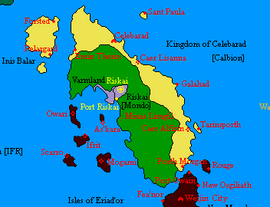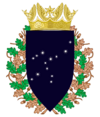Kingdom of Celebarad
| Kingdom of Celebarad Teirnas Celebarad | |||
| |||
| Motto: Bidi Sêr Arian in Arwaïn en Lobir' "The Silver Stars will Guide our Path" | |||
| Anthem: | |||

| |||
| Map versions | 15.0.5 - current | ||
| Capital | Celebarad | ||
| Largest city | Pelargard, Galahad, Emin Therin | ||
| Official language(s) | Celebaradian (official language) Norse (minority language) Menelmacari (minority language) | ||
| Official religion(s) | 71% Followers of Arian 13% Norse Nazarene 9% Calbain Church 7% other | ||
| Demonym | Celebaradi | ||
| Adjective | Celebaradi | ||
| Government | Absolute Monarchy | ||
| • King | Eathel | ||
| • Most Noble Chairman of the Council | Rowan Levis | ||
| • High Priestess of Arian | Elenora Anromin | ||
| Legislature | Council of Nobles | ||
| Establishment | 1723 AN | ||
| Area | 1.185.824 km2 | ||
| Population | Around 7 million | ||
| Currency | Crown | ||
| Abbreviation | CEL | ||
| Driving side | right | ||
| Time zone(s) | CMT+9 | ||
| National animal | Stag | ||
| National drink | River Wine | ||
The Kingdom of Celebarad (Celebaradian Tiernas Celebarad, or known as simply Celebarad) is a constituent country of Calbion located on North Island of Feanoria in the Great Western Sea. The Kingdom was founded by the Inhabitants of the great city of Celebarad, after which the Kingdom was to be named. Celebarad is a client kingdom of Calbion. The Celebradi had been in relative isolation after the collapse of the Menelmacari homeland, and the subsequent subjugation of their land and city by the Vanics. When the Calbain arrived on the shores of North Island in 1692, they allied with the Celebaradi, who had significant knowledge of the mountains and forests of their island, in order to establish their trading ports. The Kingdom of Celebarad borders the Kingdoms of Nidaros and Riskai to the West.
Etymology
The name Celebarad derives from the Menelmacari for Fortified Place of Silver, and is likely a reference to both the silver mines that lay in the North East of the Kingdom, and to the White Fortress of Celebarad. The name initially refered to the city of Celebarad, but gradually expanded to the wider Kingdom, in which case the name has taken to mean Land of Silver.
History
The City of Celebarad was founded in the 15th century by the Menelmacari. Following its foundation, it became a cultural and economic hub of the country, also influencing and controlling many of the lands in its near vicinity. After the Fall of Menelmacar, the Vanics surpressed the Celebaradi and the population drastically declined. After the Vanics left the shores of North Island, partly due to resistance from descendants of the Menelmacari, the city again gained a momentum to develop. When the Calbain arrived on the shores of Feanoria in the late 17th century, they immediately cooperated with the Celebaradi. The Calbain named the region under their control Y Afordir Corachod, or The Coast of the Elves after the Menelmacari. The Calbain, however, were mainly interested in the trading oportunities that their colonisation of the East Keltian shores provided. In 1712, they gave much of the governance of the non-port cities to the ruler of the city of Celebarad, Thawain, who they also bestowed the title of King of Celebarad. In turn, Thawain and the Celebaradi controlled the entire Eastern and Northern shores of the North Island, adding the previously independent towns and cities to their kingdom. In 1719, the island of Balar offically became part of the kingdom. The same year, King Thawain died and was succeeded by his brother, King Eathel.
Governance
Celebarad is a Kingdom and ruled as an absolute monarchy by its king. Current king is Eathel, who serves since 1719. The King is aided in his governance by the Council of Nobles, who are appointed by the King and serve at his pleasure and dismissal. Notwithstanding the authoritarian nature of the governance of the Kingdom, Celebarad has a high level of civil development and citizens have a high degree of freedom to organise their lives in guilds, communities or Burgherships. The King resides in the Silver Palace, which is also the meeting place of the Council of Nobles.


